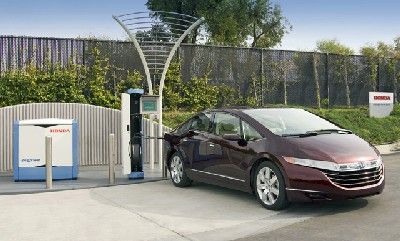Honda claims that it will introduce a fuel cell car on the market in the United States in 2008. Until recently, Honda had not been making headlines with their technological advances in battery technology or alternative fuels, but were instead portrayed as still licking the wounds inflicted by the Prius’ success in the hybrid market.
So what gives? Has Honda leapfrogged everyone? Or is this a publicity stunt?
Bet on the stunt.
Building a hydrogen powered car isn’t so hard, provided you’re prepared to lose a lot of money doing it. Chevrolet has 100 of them circulating on the roads in Southern California, in the hands of an eclectic cross-section of people. BMW, of course, has been letting celebrities drive the Hydrogen 7 for several months. So far, no one has managed to roll one of these up into a nice metal ball by running it into, say, a Super Duty 250, but that’s going to have to happen one of these days, and it will be instructive to see what happens when that occurs.
But, in the meantime, there’s Honda’s marketing of a hydrogen powered car: sounds so environmentally friendly, a car that creates no pollution, only water. And who can be opposed to water? Especially in California. You might even be able to get a fire insurance discount for having a hydrogen car – when the Santa Ana winds come around, maybe you could just have the entire neighborhood idle their hydrogen cars and create a rain cloud.
Honda’s FCX concept car – which looks very much like a Prius with more rounded lines – is supposed to be the “precursor” to the production car in 2008. Honda claims it generates 134 hp and can go 354 miles on a single tank of hydrogen. It also claims that the car can be fueled at home.
Really? With what? Hydrogen?
Hydrogen gas mixes readily with air and, when so mixed, is extremely explosive. It also is rapidly absorbed into tissue by breathing and can cause unconsciousness and death. So, if your neighbor is pumping a load of hydrogen into his tank next door, he may explode your house, too.
Hydrogen becomes violently combustible when heated, and reacts violently with oxygen, creating an extreme explosion hazard. When your neighbor has the car parked on the blacktop driveway in Phoenix in the summer, you have to hope he’s not barbequing near it, too.
Then, there’s storage. One gram – that’s one gram – of hydrogen gas occupies almost three gallons of space at atmospheric pressure. So, storing hydrogen means it must be kept under very high pressure. The only way to avoid that is to use an alloy that can both store and release hydrogen as the means of containing it. This is what is done with nickel hydride batteries. But this isn’t practical for an automobile, because it doesn’t store enough. So, hydrogen as a fuel must be kept under thousands of pounds of pressure. That’s not only impractical, it’s expensive.
Oh, and one other thing – producing all of that hydrogen requires fossil fuels to accomplish. So, the energy is going into creating the hydrogen, rather than the gas tank. But, it’s not clear that there is any gain in doing it that way.
For some reason, automakers – especially those from Japan – seem invested in the idea that hydrogen is a realistic fuel. Perhaps that’s what happens when your country is devoid of its own natural resources. Mazda had a hydrogen car a few years back, also displayed with much hoopla. But before Honda or any other car maker is going to introduce a hydrogen powered car to the market, it is going to have to address the problems of safety and infrastructure – and Honda’s not saying a syllable about how it intends to do any of that.
In the meantime, just contemplate what’s going to happen when the federal regulators and the safety mavens get a chance to go after “big hydrogen” and all of those cars with bombs for fuel tanks.
Somebody will probably write a best-seller about it.
“Unsafe at Any Speed,” maybe?

